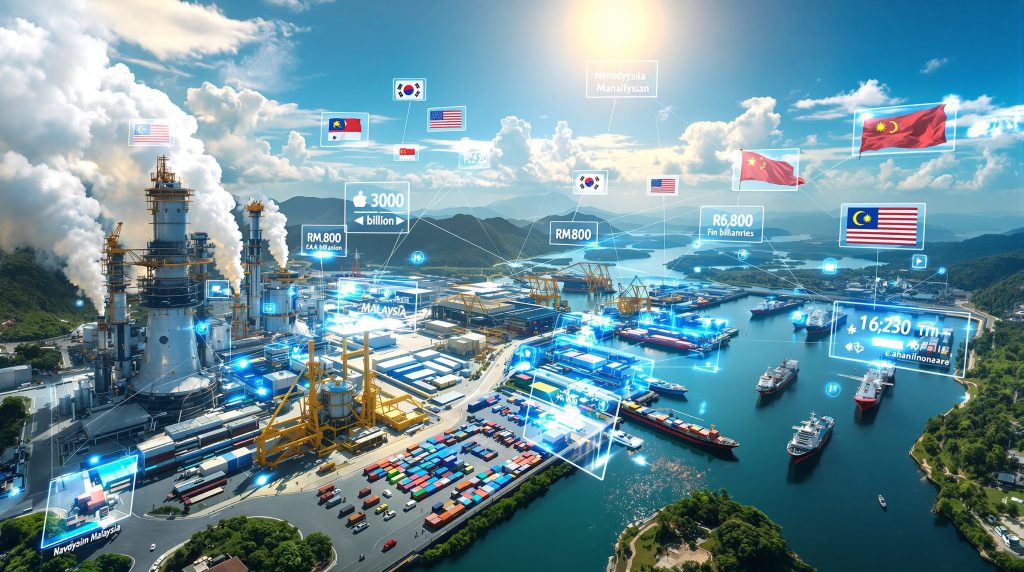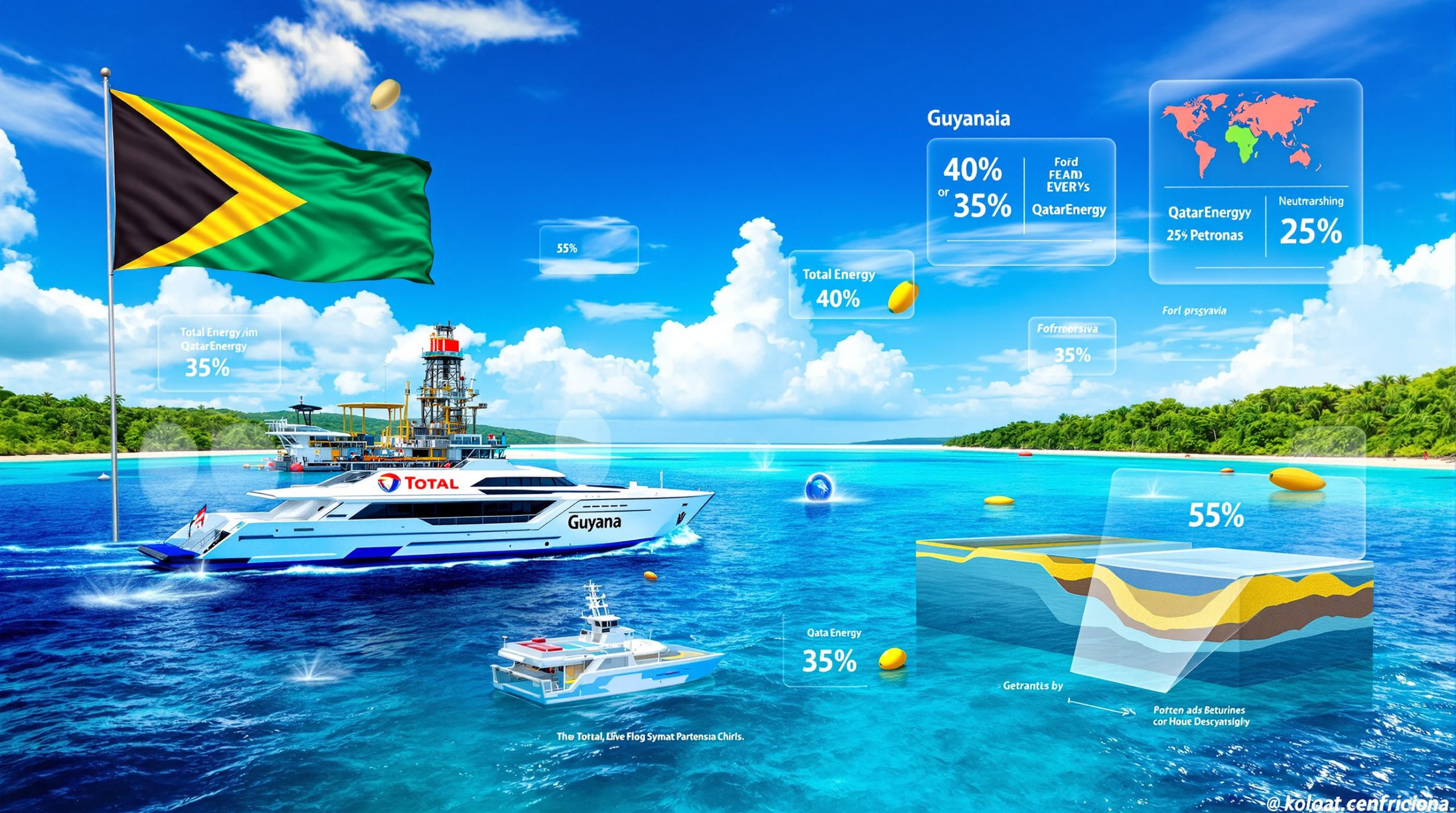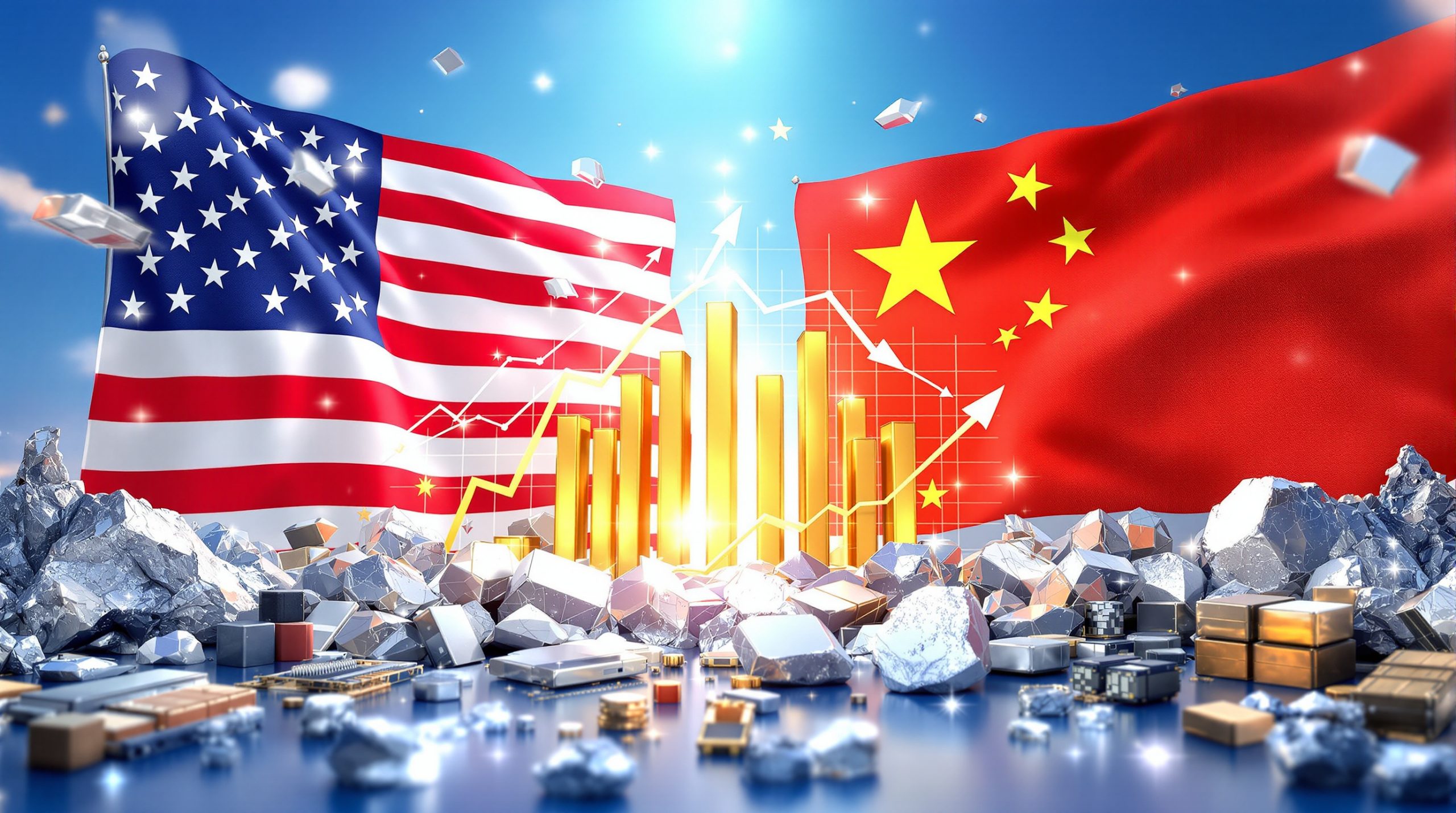Malaysia's Strategic Positioning in Critical Minerals
Malaysia has emerged as a pivotal force in global rare earth dynamics, leveraging its substantial mineral reserves through sophisticated diplomatic partnerships. Malaysia's magnet diplomacy centers on transforming 16.1 million tonnes of non-radioactive rare earth elements, valued at approximately RM800 billion according to Malaysian Ministry of Investment, Trade and Industry (MITI) data, into strategic industrial leverage.
The cornerstone of this strategy involves developing downstream processing capabilities through carefully orchestrated international collaborations. Rather than committing exclusively to any single power bloc, Malaysia maintains parallel relationships with major global players including South Korea, the United States, and China. This multi-polar approach reflects a calculated response to supply chain vulnerabilities and geopolitical tensions affecting critical mineral markets, particularly in light of ongoing US‑China trade tensions.
Technology Transfer and Industrial Development
Malaysia faces a fundamental challenge despite its resource wealth: the nation lacks indigenous processing expertise for value-added rare earth manufacturing. This technological gap necessitates foreign partnerships while creating opportunities for strategic bargaining. The country currently operates at the early stages of the rare earth supply chain, focusing on mining and initial processing rather than downstream permanent magnet production.
Furthermore, the nation's strategy emphasizes high-value neodymium-iron-boron (NdFeB) magnet manufacturing, targeting applications in electric vehicles, wind turbines, and advanced electronics. These permanent magnets represent the most critical technology for modern renewable energy and transportation systems. Global electric vehicle production requires approximately 1-2 kilograms of permanent magnets per vehicle according to International Energy Agency assessments.
The development of these capabilities aligns with broader critical minerals energy transition requirements as nations seek to secure supply chains for renewable technologies.
The Malaysia-South Korea Partnership Framework
The collaboration between Malaysian government-linked companies and South Korean technology partners exemplifies Malaysia's magnet diplomacy approach. Prime Minister Anwar Ibrahim announced in November 2025 that Malaysia and South Korea had agreed to expand rare earth collaboration, specifically targeting a 3,000-tonne annual NdFeB magnet production facility in Pahang state.
Partnership Structure and Implementation
The arrangement builds on a July 2025 memorandum between Lynas Rare Earths Ltd and South Korea's JS Link, leveraging existing rare earth processing infrastructure at the Kuantan facility. This partnership represents a model of horizontal integration where:
- Malaysian entities provide raw material access and facility development
- Korean partners contribute manufacturing expertise and market connections
- Co-located operations reduce transportation costs and supply chain complexity
- Technology transfer agreements enhance Malaysian processing capabilities
South Korea's motivation stems from structural supply chain vulnerabilities. The nation operates approximately 40% of global permanent magnet motor manufacturing capacity, primarily serving electric vehicle applications through companies like Samsung, LG, and Hyundai. However, South Korea faces limited domestic rare earth deposits and historical dependence on Chinese processing technology.
Technical Manufacturing Specifications
NdFeB magnet production requires sophisticated processing capabilities:
-
Raw material preparation: Combining neodymium oxide, dysprosium oxide, iron powder, and boron compounds
-
Smelting and alloying: Creating rare earth-iron-boron master alloys at temperatures exceeding 1,400°C
-
Hydrogen decrepitation: Breaking alloys into powder suitable for magnet formation
-
Magnetic field compaction: Pressing powder under controlled magnetic conditions
-
Sintering: Heating in controlled atmospheres at 1,100-1,200°C to achieve final density
-
Machining and quality assurance: Final shaping and performance testing
High-performance NdFeB magnets achieve energy densities of 50-55 MGOe (megaGauss-Oersteds) with operating temperature ranges from -20°C to +150°C for standard applications. Enhanced thermal stability grades incorporating dysprosium additives serve demanding applications like electric vehicle motors operating under extreme conditions.
US-Malaysia Trade Relations and Strategic Implications
The Reciprocal Trade Agreement (ART) between Malaysia and the United States introduces specific considerations for Malaysian rare earth export policy. Prime Minister Anwar Ibrahim acknowledged that whilst the agreement includes provisions affecting certain policy tools, it does not constitute subordination to American strategic interests.
Agreement Provisions and Constraints
The ART framework addresses rare earth trade through several mechanisms:
| Provision Type | Implication | Malaysian Response |
|---|---|---|
| Export quota limitations | Restricts discriminatory practices against US importers | Emphasis on maintaining policy sovereignty |
| Most favoured nation clauses | Equal treatment requirements for US rare earth procurement | Continued multi-partner engagement |
| Processing incentives | Encouragement of value-added manufacturing | Alignment with domestic industrialisation goals |
The United States maintains strategic defence stockpile requirements for critical materials, with rare earth import dependence reaching approximately 80% from Chinese sources according to US Geological Survey assessments. Malaysia represents a secondary diversification target alongside Australia and other Southeast Asian producers.
Balancing Act Challenges
Malaysia's magnet diplomacy faces several practical constraints. Whilst maintaining relationships across geopolitical divides offers economic advantages, it also creates potential coordination challenges. The nation must navigate:
- Technology transfer restrictions: Different partners may impose limitations on knowledge sharing with competitors
- Export allocation pressures: Multiple partners seeking preferential access to Malaysian resources
- Investment timing conflicts: Competing infrastructure development timelines and priorities
- Environmental compliance variations: Different international standards for processing operations
China's Role in Malaysia's Rare Earth Strategy
China's engagement with Malaysia includes potential collaboration through sovereign wealth fund partnerships, representing another dimension of the nation's multi-polar approach. Premier Li Qiang's discussions with Malaysian officials have explored processing facility development through Khazanah Nasional Berhad.
Chinese Strategic Interests
China currently dominates global rare earth processing, controlling an estimated 60-85% of worldwide processing capacity according to US Geological Survey data. The nation has historically responded to supply chain competition by investing in rare earth operations across multiple countries, including Myanmar, Vietnam, and Mozambique.
Chinese involvement in Malaysian rare earth development serves several strategic purposes:
- Supply chain security: Maintaining access to non-Chinese rare earth sources
- Technology leverage: Sharing processing expertise whilst retaining competitive advantages
- Regional influence: Strengthening economic ties within Southeast Asia
- Market positioning: Countering US and allied diversification efforts
Processing Technology Considerations
China possesses the most advanced rare earth separation and processing technologies globally, developed through decades of industrial investment and research. Malaysian partnerships with Chinese entities could provide access to:
- Solvent extraction systems for individual rare earth element separation
- Environmental remediation technologies for processing waste management
- Quality control systems ensuring consistent product specifications
- Market access networks connecting Malaysian production to global supply chains
These technological capabilities complement global trends in mining innovation trends that emphasise sustainable and efficient processing methods.
Economic Development Implications
Malaysia's magnet diplomacy strategy aims to capture maximum economic value from the nation's rare earth endowment whilst building indigenous industrial capabilities. The transformation from raw material exporter to processed goods producer requires substantial infrastructure investment and workforce development.
Value Creation Potential
The economic benefits of successful rare earth industrialisation extend beyond immediate revenue generation:
Direct Economic Impact:
- High-skilled manufacturing employment creation
- Foreign direct investment attraction across multiple sectors
- Technology transfer absorption building indigenous expertise
- Export diversification reducing commodity dependence
Indirect Economic Benefits:
- Downstream industry development in electronics and renewable energy
- Research and development capacity building at Malaysian universities
- Supply chain integration with regional ASEAN partners
- Enhanced negotiating position in international trade relationships
This approach reflects broader mineral beneficiation strategies that seek to maximise value from natural resource endowments through downstream processing.
Investment Requirements and Risks
Permanent magnet manufacturing facilities typically require $50-150 million in capital investment depending on production capacity and technology sophistication. Malaysia's partnerships distribute these costs across multiple stakeholders whilst sharing associated risks.
However, several risk factors could complicate successful implementation:
- Technology dependency: Continued reliance on foreign expertise limits strategic autonomy
- Market volatility: Rare earth prices subject to significant fluctuations based on global demand
- Environmental liabilities: Processing operations require comprehensive waste management systems
- Geopolitical tensions: Escalating US-China competition could force difficult partnership choices
Comparative Regional Strategies
Malaysia's approach contrasts with more aligned strategies adopted by other significant rare earth producers, offering both advantages and potential complications in global supply chain positioning.
Australia's Western Alignment
Australia has pursued strong alignment with US and allied supply chains, focusing processing partnerships exclusively with democratic nations. The Australian strategy emphasises clear positioning within Western supply chain frameworks, accepting potential limitations on Chinese market access in exchange for security partnership benefits.
Key elements of Australia's approach include:
- Exclusive partnerships: Priority given to US, Japanese, and European investors
- Security integration: Rare earth development tied to defence cooperation agreements
- Technology sharing: Open collaboration with allied research institutions
- Market focus: Primary targeting of Western manufacturing supply chains
Indonesia's Resource Nationalism
Indonesia has implemented more restrictive policies, requiring significant domestic processing before export authorisation. This approach prioritises value-added manufacturing whilst limiting foreign control over strategic resources.
Malaysia's differentiation from regional competitors involves:
- Flexibility maintenance: Avoiding exclusive commitments to any single power bloc
- Economic prioritisation: Emphasising commercial benefits over security considerations
- Partnership diversity: Simultaneous engagement with competing global powers
- Technology pragmatism: Accepting expertise from multiple sources regardless of geopolitical alignment
Future Supply Chain Implications
Malaysia's magnet diplomacy could establish a new template for resource-rich nations seeking to maximise economic benefits whilst maintaining strategic flexibility. The success or failure of this approach will influence broader patterns in critical mineral supply chain development.
Regional Hub Development Potential
If successfully implemented, Malaysia's strategy could position the nation as Southeast Asia's primary rare earth processing centre. This development would contribute to:
Supply Chain Diversification:
- Reduced concentration in Chinese processing facilities
- Enhanced resilience for global manufacturers
- Alternative sourcing options for critical applications
- Regional integration of ASEAN mineral resources
Geopolitical Implications:
- Demonstration of non-aligned resource development strategies
- Potential template for other developing nations with strategic minerals
- Contribution to multipolar supply chain architecture
- Reduced dependency on single-source suppliers
The broader context of rare earth reserves analysis indicates that successful Malaysian processing capabilities could significantly impact global supply chain dynamics.
Technology Transfer Success Factors
The ultimate measure of Malaysia's strategy will be its ability to absorb foreign technologies and develop genuine indigenous capabilities. Critical success factors include:
- Knowledge retention systems: Ensuring technology transfer creates lasting Malaysian expertise
- Workforce development programmes: Training local technicians and engineers
- Research infrastructure investment: Building Malaysian rare earth research capabilities
- Regulatory framework development: Creating competitive but sustainable industry standards
Investment and Market Considerations
For investors and industry stakeholders, Malaysia's rare earth strategy presents both opportunities and uncertainties. The nation's resource endowment and strategic positioning offer compelling advantages, but implementation risks require careful evaluation.
Market Opportunity Assessment
Global demand for permanent magnets continues expanding driven by:
Electric Vehicle Growth:
- Annual EV production reaching 14 million units globally in 2023
- Each vehicle requiring 1.5-2 kg of permanent magnets
- Projected market growth of 20-30% annually through 2030
Renewable Energy Expansion:
- Offshore wind turbines containing 600-800 kg of permanent magnets per 10 MW unit
- Global wind capacity additions of 100-120 GW annually
- Solar tracking systems increasingly utilising permanent magnet motors
Advanced Electronics Applications:
- Drone and aerospace motor systems requiring high-performance magnets
- Consumer electronics miniaturisation driving magnet demand
- Defence applications with specialised performance requirements
Risk Mitigation Strategies
Stakeholders evaluating Malaysian rare earth investments should consider several risk mitigation approaches:
- Partnership diversification: Avoiding exclusive dependence on single technology partners
- Contract flexibility: Negotiating adaptive terms accommodating geopolitical changes
- Environmental compliance: Ensuring processing operations meet international standards
- Market hedging: Managing price volatility through forward contracts and supply agreements
What Are the Long-term Implications for Global Markets?
The broader implications of Malaysia's strategy extend to global supply chain architecture and geopolitical stability. Successful implementation could demonstrate that resource-rich nations need not choose between major powers to develop strategic minerals effectively.
Furthermore, this approach could influence other Southeast Asian nations with similar mineral endowments, including Vietnam, Myanmar, and Thailand. The creation of multiple processing hubs across the region would enhance supply chain resilience and reduce dependence on single-country processing capabilities.
However, the complexity of managing simultaneous partnerships with competing powers requires sophisticated diplomatic and commercial capabilities that not all nations possess.
Conclusion and Strategic Outlook
Malaysia's magnet diplomacy represents a sophisticated attempt to transform natural resource advantages into lasting industrial capabilities whilst navigating complex geopolitical realities. The nation's multi-partner approach offers flexibility but also creates coordination challenges requiring careful management.
Success will ultimately depend on Malaysia's ability to:
- Absorb foreign technologies whilst building indigenous expertise
- Maintain balanced relationships across competing international partners
- Develop competitive processing capabilities that justify continued foreign investment
- Manage environmental and social impacts ensuring sustainable operations
The global implications extend beyond Malaysia's borders. If successful, this strategy could provide a template for other resource-rich nations seeking to maximise economic benefits from strategic minerals without sacrificing diplomatic flexibility. However, the challenges of technology dependency, geopolitical pressure, and market volatility require continuous adaptation and strategic refinement.
The approach reflects broader trends in critical mineral diplomacy, where nations seek to balance economic development goals with strategic autonomy. As global demand for rare earth elements continues expanding, Malaysia's experience will provide valuable insights into the viability of non-aligned resource development strategies.
This analysis is based on publicly available information and official government statements. Rare earth markets involve significant volatility and geopolitical risks that could affect investment outcomes. Readers should conduct independent research and seek professional advice before making investment decisions related to critical mineral supply chains.
Looking to Capitalise on Malaysia's Rare Earth Strategy?
Discovery Alert's proprietary Discovery IQ model delivers real-time notifications on significant ASX mineral discoveries, including rare earth and critical mineral announcements that could benefit from Malaysia's expanding downstream processing capabilities. Gain immediate insights into actionable trading opportunities by exploring Discovery Alert's dedicated discoveries page showcasing historic examples of exceptional returns, then begin your 30-day free trial to position yourself ahead of the market.




